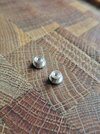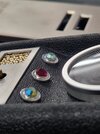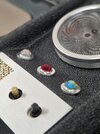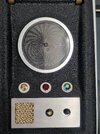You are using an out of date browser. It may not display this or other websites correctly.
You should upgrade or use an alternative browser.
You should upgrade or use an alternative browser.
TOS Communicator Build
- Thread starter turner3d
- Start date
turner3d
Well-Known Member
I'm already going to be getting circuit boards printed by them - if I can't find a resin durable enough to print myself, I'll definitely give them the job. Really, all the gear has to put up with is the friction of having the little gear roll over its teeth - there's practically no torque being put on itThere may also be an option of having metal or nylon gears printed by PCB Way. They seem to be very reasonable with their pricing and have a quick turnaround time.
E
turner3d
Well-Known Member
I'm torn: should I run the moire smoothly, or should I simulate the ticking of the original props?
Examining footage of stopwatch-driven moires frame by frame, each tick starts off very fast, decelerates for the first half of the tick, and comes to a stop, resting for the last half. This happens 6 times per second, assuming that the info I've gathered on Alpha's original Telmex Trading Co stopwatch is accurate. It is very difficult to quantify its behavior, since it only shows up for 8.5 seconds TOTAL across all 3 seasons of the show. Here is all of the footage that exists of Alpha's moire:
Much of what I've learned about stopwatch-driven moires has come from footage of fan-built replicas. I've been working on the code to make the stepper motor simulate the motion produced by the original stopwatch - it's not perfect, but I think I'm zeroing in on it.
Emulating this ticking means accelerating the moire platter very quickly and decelerating to a stop 6 times a second. There are a couple of down sides to this. While the moire doesn't weigh much and spins very freely on a carbon steel bearing, the teeth in the outer ring gear are less than 1/2mm apart. They are so tiny that I couldn't even see if they printed or not prior to washing off the excess resin. The constant starting and stopping will undoubtedly wear things out much faster than spinning it smoothly. The other down is that this also makes the motor it slightly audible. It's not much, but it's also not nothing.
There is one other advantage to running it smoothly - it looks absolutely hypnotic. I'd love to know what you guys think. Should I try to stay canon, or do I make it smooth?
Examining footage of stopwatch-driven moires frame by frame, each tick starts off very fast, decelerates for the first half of the tick, and comes to a stop, resting for the last half. This happens 6 times per second, assuming that the info I've gathered on Alpha's original Telmex Trading Co stopwatch is accurate. It is very difficult to quantify its behavior, since it only shows up for 8.5 seconds TOTAL across all 3 seasons of the show. Here is all of the footage that exists of Alpha's moire:
Much of what I've learned about stopwatch-driven moires has come from footage of fan-built replicas. I've been working on the code to make the stepper motor simulate the motion produced by the original stopwatch - it's not perfect, but I think I'm zeroing in on it.
Emulating this ticking means accelerating the moire platter very quickly and decelerating to a stop 6 times a second. There are a couple of down sides to this. While the moire doesn't weigh much and spins very freely on a carbon steel bearing, the teeth in the outer ring gear are less than 1/2mm apart. They are so tiny that I couldn't even see if they printed or not prior to washing off the excess resin. The constant starting and stopping will undoubtedly wear things out much faster than spinning it smoothly. The other down is that this also makes the motor it slightly audible. It's not much, but it's also not nothing.
There is one other advantage to running it smoothly - it looks absolutely hypnotic. I'd love to know what you guys think. Should I try to stay canon, or do I make it smooth?
turner3d
Well-Known Member
I'm afraid I don't know - I have pretty much no experience with rhinestones. I just searched until I found a reputable retailer that had ss16 size stones in Siam, Olivine AB, and Crystal AB. I can't say how their quality or sparkle compares to others, but they're pretty!I noticed the rhinestones you got from bluestreak crystals aren't swarovski. Do the Estella range you bought have the same quality in shimmer etc?
I read that the discontinued Swarovski model 2000 stones have 8 facets and these have 10, and the Bluestreak profile is a tiny bit taller. I tried like crazy to get Swarovskis for the sake of authenticity, but nobody will let you even look at a catalog anymore if you don't have some sort of commercial manufacturing license.
I can't find anything wrong with them and I think they look really good, but like I said - I don't really know what I'm talking about on this one
Simonized
Well-Known Member
I have access to a the 2000 range but they're limited in supply for obvious reasons, I’ve got them on all my modded wand comms as well as the correct vintage transistor radio meshI'm afraid I don't know - I have pretty much no experience with rhinestones. I just searched until I found a reputable retailer that had ss16 size stones in Siam, Olivine AB, and Crystal AB. I can't say how their quality or sparkle compares to others, but they're pretty!
I read that the discontinued Swarovski model 2000 stones have 8 facets and these have 10, and the Bluestreak profile is a tiny bit taller. I tried like crazy to get Swarovskis for the sake of authenticity, but nobody will let you even look at a catalog anymore if you don't have some sort of commercial manufacturing license.
I can't find anything wrong with them and I think they look really good, but like I said - I don't really know what I'm talking about on this one
I just need to add the brass grill to some of them.
The ones you have look great too!
I have an issue trying to drill the size hole I need in the aluminium t jets ... if anyone has a good idea on how to keep them in place and not spin round with the drill and without scratching or damaging them please chime in lol, otherwise it's taking me forever.
Attachments
turner3d
Well-Known Member
Got everything breadboarded up and the code for the stepper-driven moire merged with the code for the audio in the new communicator setup. Everything is working, but there's an unwanted delay on playback from the sound board even though I can see that it's getting the signal over the serial connection immediately. I suspect the sound board itself. It's supposed to be a DFPlayer Mini, but its labeling isn't right - looks like it's a knock off. Also note that I'm controlling everything with an Uno instead of an ATtiny85 - this is for the sake of prototyping speed, since uploading new firmware to the ATtiny is a pain.
Long story short: more progress and more obstacles. It's the usual story. If anyone has any ideas about something else that could cause delays in DFPlayer playback when controlled via serial connection, I'd love to hear them.
7/30 Edit: I swapped in a different DF Player board, and that was it. Playback is now instantaneous. Looks like it's time to finalize the PCB design and start cranking them out!
Long story short: more progress and more obstacles. It's the usual story. If anyone has any ideas about something else that could cause delays in DFPlayer playback when controlled via serial connection, I'd love to hear them.
7/30 Edit: I swapped in a different DF Player board, and that was it. Playback is now instantaneous. Looks like it's time to finalize the PCB design and start cranking them out!
Last edited:
That's a beauty! Fingers crossed that you make several of these. Your dedication is admirable.I thought my journey on this one was almost done, but it turns out that I'm just getting started. I posted a video of the finished communicator in a Facebook prop-enthusiasts group and was swamped with requests to buy one. I've decided that I'm going to try to do a small run of them, and as a result, I have a few new goals:
1. Reduce production time - the antenna in particular takes WAY too long to get as smooth as I'd like. To reduce post-processing time, I finally bit the bullet and got myself a resin printer. The first thing I printed was an antenna, and holy cow - it came straight out of the wash & cure station pretty much ready for paint.
View attachment 1947975
2. I want to finally get the moire up to 2 RPM. It still looks really cool at 1 RPM with the hacked up clock movement, but I want to get it up to 2. I have been investigating tiny stepper motors to drive the moire in an internal gear arrangement with a tiny bearing in the center. The motion of the original moires weren't completely smooth - as I understand it, they ticked 6 times a second, giving it a bit of a stuttering motion. I may experiment with trying to duplicate that as well, but I'll have to see how it goes.
View attachment 1947973View attachment 1947974
If I can get it to work and if it's quiet enough, it will have the added benefit of freeing up a TON of space inside. I will need more space since I will also need a stepper motor controller board (I have a DRV8834 ordered) as well as a charger board for the LiPo battery. I'll also be looking into getting a little "motherboard" printed up at PCBWay - I don't want to be making these with the spaghetti of wires inside like my current build has. I really want to get the DF Player board, the ATtiny85 microcontroller, the stepper motor board, and the battery charger all mounted in one place.
I'm currently waiting on a bunch of parts to come in from AliExpress, Amazon, and elsewhere - I'll keep the updates coming.
Smooth! I'd love to have a bigger one for my desk, like the one at Spock's station.I'm torn: should I run the moire smoothly, or should I simulate the ticking of the original props?
Examining footage of stopwatch-driven moires frame by frame, each tick starts off very fast, decelerates for the first half of the tick, and comes to a stop, resting for the last half. This happens 6 times per second, assuming that the info I've gathered on Alpha's original Telmex Trading Co stopwatch is accurate. It is very difficult to quantify its behavior, since it only shows up for 8.5 seconds TOTAL across all 3 seasons of the show. Here is all of the footage that exists of Alpha's moire:
View attachment 1952879
Much of what I've learned about stopwatch-driven moires has come from footage of fan-built replicas. I've been working on the code to make the stepper motor simulate the motion produced by the original stopwatch - it's not perfect, but I think I'm zeroing in on it.
View attachment 1952873
Emulating this ticking means accelerating the moire platter very quickly and decelerating to a stop 6 times a second. There are a couple of down sides to this. While the moire doesn't weigh much and spins very freely on a carbon steel bearing, the teeth in the outer ring gear are less than 1/2mm apart. They are so tiny that I couldn't even see if they printed or not prior to washing off the excess resin. The constant starting and stopping will undoubtedly wear things out much faster than spinning it smoothly. The other down is that this also makes the motor it slightly audible. It's not much, but it's also not nothing.
There is one other advantage to running it smoothly - it looks absolutely hypnotic. I'd love to know what you guys think. Should I try to stay canon, or do I make it smooth?
turner3d
Well-Known Member
I've made a decision! The communicator will come apart with 2 screws. The circuit board mounted in the bottom shell will have a jumper like the ones on PC motherboards. Switching the jumper position will allow you to select either tick or smooth mode for the moire.Smooth! I'd love to have a bigger one for my desk, like the one at Spock's station.
Excellent!I've made a decision! The communicator will come apart with 2 screws. The circuit board mounted in the bottom shell will have a jumper like the ones on PC motherboards. Switching the jumper position will allow you to select either tick or smooth mode for the moire.
turner3d
Well-Known Member
I'm honestly still not sure about the range to make available. I'll definitely be offering fully assembled units, but I'm not sure about kits. There are a lot of parts and some super tiny solder work - I I don't think I'd want to put out a kit that has a high chance of being messed up during assembly and then having to deal with replacement parts & unhappy customers.Based on all the information you have now, and considering the various levels of difficulty with everything involved, are you still leaning toward offering fully assembled units or kits? Do you have price points in mind yet?
These are some other considerations:
- There will be a USB-C jack at the bottom of the communicator with a charge indicator next to it (red = charging, green = charged). The indicator will be tied to LEDs on the charging board and piped to a 1mm dot on the bottom of the shell via fiber optic
- The case will come apart with 2 screws
- There will be very little glue used so that parts can be easily replaced/modded - most pieces are designed to be held in place from the force of the 2 main screws, except for the motherboard which will be held in with 3 screws of its own
- The sound board has a removable SD card which will allow modification of the sounds and dialog
- The ATtiny85 microcontroller will be mounted in a socket so that it can be removed and reprogrammed via Arduino IDE
- The moire will come in Alpha config, but will also be easy to disassemble so that it can have its radial patterns swapped out, even replaced with other arrangements like Beta's
feek61
Sr Member
I LOVE "tick mode!"Got everything breadboarded up and the code for the stepper-driven moire merged with the code for the audio in the new communicator setup. Everything is working, but there's an unwanted delay on playback from the sound board even though I can see that it's getting the signal over the serial connection immediately. I suspect the sound board itself. It's supposed to be a DFPlayer Mini, but its labeling isn't right - looks like it's a knock off. Also note that I'm controlling everything with an Uno instead of an ATtiny85 - this is for the sake of prototyping speed, since uploading new firmware to the ATtiny is a pain.
View attachment 1954247
Long story short: more progress and more obstacles. It's the usual story. If anyone has any ideas about something else that could cause delays in DFPlayer playback when controlled via serial connection, I'd love to hear them.
7/30 Edit: I swapped in a different DF Player board, and that was it. Playback is now instantaneous. Looks like it's time to finalize the PCB design and start cranking them out!
Amazing job!
That’s a tough one.
Parts + labor + profit + misc = ???
You’ve got to make it worth your while, but you might have to eat-it a little at first. In the end, you need to decide what it’s worth to you.
Once you get the kinks out, would it be hard to make a bunch? You could hold a Dutch auction. Everybody lists the highest price they'd pay. Rank the prices. If you have 10 for sale, the 10 highest bidders pay the 11th highest price.I'm honestly still not sure about the range to make available. I'll definitely be offering fully assembled units, but I'm not sure about kits. There are a lot of parts and some super tiny solder work - I I don't think I'd want to put out a kit that has a high chance of being messed up during assembly and then having to deal with replacement parts & unhappy customers.
These are some other considerations:
As for the price point, I'm not sure about that either, though I'm open to suggestions. What do you think a hand-built piece like this should go for?
- There will be a USB-C jack at the bottom of the communicator with a charge indicator next to it (red = charging, green = charged). The indicator will be tied to LEDs on the charging board and piped to a 1mm dot on the bottom of the shell via fiber optic
- The case will come apart with 2 screws
- There will be very little glue used so that parts can be easily replaced/modded - most pieces are designed to be held in place from the force of the 2 main screws, except for the motherboard which will be held in with 3 screws of its own
- The sound board has a removable SD card which will allow modification of the sounds and dialog
- The ATtiny85 microcontroller will be mounted in a socket so that it can be removed and reprogrammed via Arduino IDE
- The moire will come in Alpha config, but will also be easy to disassemble so that it can have its radial patterns swapped out, even replaced with other arrangements like Beta's
That’s a tough one.
Parts + labor + profit + misc = ???
You’ve got to make it worth your while, but you might have to eat-it a little at first. In the end, you need to decide what it’s worth to you.
Well said. And just asking what a fair price is speaks volumes.
I personally would really like your tick version as a stand alone unit that could go in an existing comm replica. something that could be glued
to the upper shell with the circle cut out. i don't really care about sound and the stop watch versions tend to quit over time due to the fact
that they are about 50 plus years old.
to the upper shell with the circle cut out. i don't really care about sound and the stop watch versions tend to quit over time due to the fact
that they are about 50 plus years old.
Similar threads
- Replies
- 2
- Views
- 702
- Replies
- 10
- Views
- 2,043





